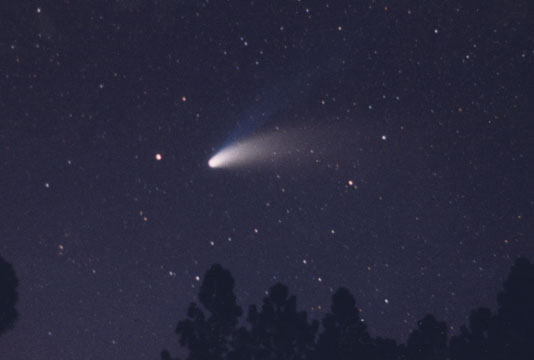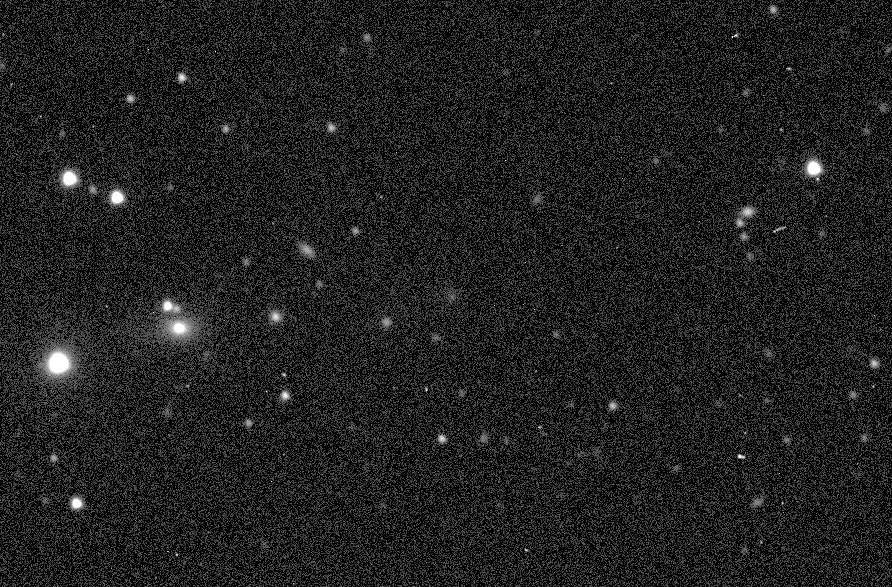
NOTABLE UPCOMING COMETS

For planning purposes, on this page I will list the incoming comets that are expected to become moderately bright or otherwise notable within the next one to two years, and which I expect to add to my tally (if I haven't already). I don't intend this list to be exhaustive, but instead will focus on those comets that are worthy of attention from sky-watchers and other interested people (including, certainly, students) who would not normally be considered "comet astronomers." I plan to update this page every one to two months and/or as necessary.
The "long-range" comets listed at the end of this page are, as implied, mentioned here primarily for long-range planning purposes.
COMET PANSTARRS C/2021 O3 (Perihelion 2022 April 21)
According to preliminary orbital calculations this recently-discovered long-period comet passes through perihelion at a heliocentric distance of 0.29 AU. At that time it will be in the evening sky at an elongation of 17 degrees, and although the elongation remains between 15 and 17 degress through the end of April, the comet is moving northward, with the elongation increasing to 30 degrees by the end of the first week of May and to 45 degrees by the middle of that month. By that time it is in northern circumpolar skies, and it reaches a peak northerly declination of +82 degrees shortly before the end of May. The comet appears at a maximum phase angle of 136 degrees just before the end of April and is nearest Earth (0.60 AU) a week and a half later.
At this time Comet PANSTARRS is a very faint object between 19th and 20th magnitude. As is always true for newly-discovered long-period comets, brightness predictions for the time during and after perihelion are problematical, and this comet's behavior will likely depend on such factors as to whether or not it is a "new" comet making its first visit from the Oort Cloud and also its dust content -- none of which are known at present. The potential for a bright display certainly exists, although it is also entirely possible that it could brighten slowly and become a relatively unimpressive object, and conceivably could even disintegrate as it approaches and passes through perihelion. We will just have to wait and see what happens over the coming months.
COMET 73P/SCHWASSMANN-WACHMANN 3 (Perihelion 2022 August 25)
We may, or may not, have been seeing the break-up of this comet over the past couple of decades. During its return in 1995 (no. 202) its nucleus split into four discrete fragments as the comet itself underwent a dramatic outburst to 5th magnitude. Various fragments have been seen at most of its returns since then, including in 2006 (no. 385) when it passed within 0.08 AU from Earth and I detected three discrete "companion" comets in addition to the primary one, and over 60 nuclear fragments were detected with large telescopes. Even at the most recent return, in 2017 (no. 612), which took place under mediocre viewing geometry, one additional "companion" comet appeared which for a time was brighter than the primary component. It has already been recovered in January 2021 by the Lowell Discovery Telescope in Arizona as a very faint object near 23rd magnitude, and when near perihelion will be visible in the western evening sky, albeit more favorably placed for observers in the southern hemisphere; it may be around 11th magnitude at the time. Although this is very uncertain, there is a possibility of a strong meteor shower from this comet in 2022, with some predictions suggesting that this could occur in late May from a radiant in southwestern Bootes.
COMET 81P/WILD 2 (Perihelion 2022 December 15)
I have observed this comet at every return it has made in my lifetime, beginning with its discovery return in 1978 (no. 26), and I discuss it in detail in the entry I wrote when I observed it as a part of "Countdown" during its return in 2010 (no. 463). The 2022 return is moderately favorable, with the comet's being in the morning sky at an elongation of 55 degrees at the time of perihelion, and subsequently at opposition in June 2023. The viewing geometry is almost identical to that of the return in 1990 (no. 146), when I followed it for eight months and it reached a peak brightness near 12th magnitude.
COMET 12P/PONS-BROOKS (Perihelion 2024 April 21)
This "classical" Halley-type comet (period 70 years) last returned in 1954, four years before I was born. The viewing geometry in 2024 is, unfortunately, rather unfavorable, as during the run-up to perihelion the comet remains on the far side of the sun from Earth and is only visible for a brief period of time in the northwestern sky after dusk, at a small elongation (37 degrees in mid-March, shrinking to 28 degrees by month's end and to 23 degrees by perihelion). Despite the poor viewing geometry, the comet is intrinsically rather bright, and should reach a peak brightness close to 5th magnitude. After perihelion the comet travels southward and is visible from the southern hemisphere as it recedes and fades.
UPDATE (June 28, 2020): Comet Pons-Brooks was recovered on June 10, 2020 -- almost four years before perihelion passage -- by a team of astronomers led by Matthew Knight utilizing the Lowell Discovery Telescope in Arizona (with confirming images obtained on June 17). The comet's heliocentric distance at the time of its recovery was 11.93 AU, and it appeared as a very faint object near 23rd magnitude, with a short tail indicating that it is already active.
COMET 13P/OLBERS (Perihelion 2024 June 30)
This other "classical" Halley-type comet (period 68 years) last returned in 1956, two years after the above comet and two years before I was born. Also as with the above comet, the viewing geometry remains relatively poor, with the comet's remaining on the far side of the sun from Earth; on the other hand, it is almost identical to the viewing geometry in 1956. It remains in the northern hemisphere's evening sky throughout the period of prime visibility, albeit at a small elongation (dropping below 30 degrees in early May, to a minimum of 25.5 degrees in early June before increasing back to 30 degrees by perihelion to a maximum of 39 degrees in August). Based upon the reported brightnesses in 1956, the comet should reach a peak brightness between 6th and 7th magnitude.
Around mid-April 12P/Pons-Brooks and 13P/Olbers will be located some 15 degrees from each other, the latter comet being higher (to the east and north) of the former one.
COMET BERNARDINELLI-BERNSTEIN C/2014 UN271 (Perihelion 2031 January 22)
Intrinsically, this appears to be one of the brightest comets ever observed. It appeared on various images taken during the course of the Dark Energy Survey (at Cerro Tololo Inter-American Observatory in Chile) from October 2014 -- at which time its heliocentric distance was 29.04 AU, almost as far out as Neptune -- through November 2018, although these weren't noticed until a recent thorough examination of those images, and its discovery was reported and announced in mid-June 2021. It was initially reported as being asteroidal in appearance, however it is now beginning to show cometary activity, despite a heliocentric distance (in late June 2021) of 20.15 AU. Recent data, including a couple of images I took via the Las Cumbres Observatory network, indicate a present brightness between 18th and 19th magnitude.

 LEFT: One of the discovery images of Comet Bernardinelli-Bernstein, taken October 15, 2017, with the Dark Energy Camera attached to the 4-meter Victor Blanco Telescope at Cerro Tololo Inter-American Observatory in Chile during the course of the Dark Energy Survey. Courtesy Dark Energy Survey/DOE/FNAL/DECam/CTIO/NOIRLab/NSF/AURA/Pedro Bernardinelli and Gary Bernstein (Univ. of Pennsylvania)/DESI Legacy Imaging Surveys. RIGHT: An image I took with a 0.4-meter telescope of the Las Cumbres Observatory network at its facility at Cerro Tololo on July 7, 2021. The comet is the small, slightly diffuse object in the center.
LEFT: One of the discovery images of Comet Bernardinelli-Bernstein, taken October 15, 2017, with the Dark Energy Camera attached to the 4-meter Victor Blanco Telescope at Cerro Tololo Inter-American Observatory in Chile during the course of the Dark Energy Survey. Courtesy Dark Energy Survey/DOE/FNAL/DECam/CTIO/NOIRLab/NSF/AURA/Pedro Bernardinelli and Gary Bernstein (Univ. of Pennsylvania)/DESI Legacy Imaging Surveys. RIGHT: An image I took with a 0.4-meter telescope of the Las Cumbres Observatory network at its facility at Cerro Tololo on July 7, 2021. The comet is the small, slightly diffuse object in the center.
The comet's perihelion distance is a very large 10.95 AU -- beyond the orbital distance of Saturn, and the second-largest of any known long-period comet. It is traveling in an orbit almost perpendicular to Earth's -- inclination 95 degrees -- and will be at opposition in late March 2031, when it will be at a declination of -37 degrees, and again a year later when it will be at a declination of -22 degrees. As is always true for long-period comets, brightness predictions are problematical -- especially since there is so little information available about the behavior of inbound comets at these kinds of heliocentric distances -- but at this stage I would not expect a peak brightness any brighter than about 14th magnitude, at best.
Return to Comet Resource Center